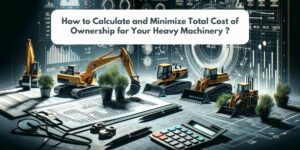The image features a visually engaging setup of heavy machinery, including excavators and bulldozers, placed on a desk surrounded by documents, calculators, and charts. The backdrop showcases financial graphs and data visualizations, symbolizing the calculation of Total Cost of Ownership (TCO) for heavy machinery in industrial businesses
Maximizing return on investment (ROI) is a vital goal for businesses, especially those dealing with expensive assets such as heavy machinery. A thorough understanding of the total cost of ownership (TCO) can be the key to achieving this goal. In this guide, we’ll explore how to calculate TCO and offer strategies to minimize it, specifically for B2B heavy machinery buyers and rental companies.
Understanding Total Cost of Ownership
Before diving into calculations, it’s essential to understand what TCO encompasses. Total cost of ownership is not limited to the purchase price of the machinery. Instead, it includes all costs associated with the acquisition, operation, and maintenance of machinery over its life cycle. These costs can be categorized into three main areas:
- Acquisition Costs: This is the upfront cost of purchasing the equipment, including transportation and installation fees.
- Operational Costs: These are day-to-day expenses, such as fuel, lubricants, and operator labor costs.
- Maintenance Costs: The ongoing costs for regular servicing, repairs, and parts replacement.
Calculating Total Cost of Ownership
Calculating the TCO involves determining the present value of each cost component over the machinery’s expected life span. Here’s a step-by-step approach:
Step 1: Determine Acquisition Costs
Start with the purchase price of the machinery. Include any additional charges you might incur during the acquisition process, such as transportation and installation.
- Purchase Price: The initial cost paid for the machine.
- Additional Costs: Any fees for delivery, taxes, installation, and setup.
Step 2: Estimate Operational Costs
Operational costs can vary based on the usage and efficiency of the machinery. Consider the following components:
- Fuel Consumption: Calculate the average fuel cost per operating hour.
- Lubricants and Fluids: Estimate the cost based on usage.
- Operator Labor: Calculate wages for the operators over the expected usage period.
Step 3: Assess Maintenance Costs
Regular maintenance is crucial for longevity and efficiency. Assess these costs annually:
- Scheduled Servicing: Routine maintenance such as oil changes and inspections.
- Repair Costs: Unplanned repairs and parts replacement.
- Downtime Costs: Potential revenue loss during maintenance downtime.
Step 4: Calculate Depreciation
Depreciation affects the resale value of machinery. Use straight-line or declining balance methods to estimate how much value your equipment loses each year.
Step 5: Estimate the Residual Value
Residual value is the expected value of the machinery at the end of its useful life. Subtract this from the total of all costs to determine the net TCO.
Strategies to Minimize Total Cost of Ownership
Reducing TCO is critical for improving ROI. Here are practical strategies to consider:
a)Regular Maintenance and Servicing
Implement a proactive maintenance schedule. Regular check-ups can prevent unexpected failures and costly repairs.
- Tip: Use technology to monitor the condition and performance of machinery. Many modern machines come equipped with telematics systems that provide data on usage and maintenance needs.
b)Operator Training and Certification
Investing in comprehensive training and certification programs for operators can improve efficiency and reduce the risk of accidents, thereby lowering operational costs.
c) Lease or Rent Options
In some cases, leasing or renting machinery may provide financial advantages over purchasing, especially for equipment with low utilization rates.
- Consideration: Evaluate the lease terms thoroughly and consider potential tax benefits
d) Fleet Optimization
Analyze your fleet to ensure you have the right equipment in the right quantity. Removing unnecessary or outdated machinery can significantly cut costs.
- Strategy: Use fleet management software to track usage patterns and make informed decisions on equipment rotation or sale.
Conclusion
Understanding and managing the total cost of ownership for heavy machinery is crucial for maximizing ROI. By following a structured approach to calculating TCO and implementing cost-saving strategies, B2B buyers and rental companies can greatly enhance their financial performance. Keep your machinery well-maintained, train your operators effectively, explore flexible financial options, and utilize technology to optimize your fleet.

